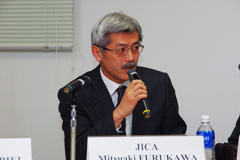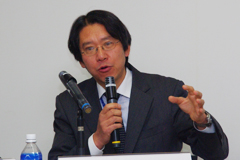Recipients’ Ownership is an Important Factor to Overcome Fragmentation of Aid, says Stephan Klingebiel, DIE, at a Joint Seminar
2017.02.15
An upsurge of aid actors, activities, and processes has created a phenomenon, known as fragmentation of aid, challenging the effectiveness and impact of international development cooperation. In this context, the German Development Institute (DIE) and JICA Research Institute (JICA-RI) co-hosted an event at the JICA Ichigaya Building in Tokyo on February 7, 2017 to present a new book entitled, “Fragmentation of Aid: Concepts, Measurements and Implications for Development Cooperation.”
In the opening remarks of this event, Naohiro Kitano, the Director of JICA-RI, shared the history of the DIE–JICA-RI partnership and introduced the presenters: Stephan Klingebiel, the Head of Department, Bi- and Multilateral Development Cooperation at DIE; Mitsuaki Furukawa, the Director General, Security Management Department at JICA/Former Executive Senior Research Fellow at JICA-RI; and Motoki Takahashi, a Professor of the Graduate School of Asian and African Area Studies at Kyoto University.
Klingebiel, the author and coeditor of the book, explained the definition of aid fragmentation using the example of the construction of an A380 aircraft, wherein the process requires highly specialized planning and construction; this demonstrated how development cooperation should be driven and coordinated.

Stephan Klingebiel, the Head of Department, Bi- and Multilateral Development Cooperation at DIE
Next, he presented three policy areas in which aid fragmentation can be identified as a challenge. First, in the area of development cooperation, he mentioned that strong overlaps similar to that of climate change mitigation activities are observed. Second, as contributors to the fragmentation of institutions, he pointed out the increasing number of bilateral donors and multilateral channels (vertical funds), the appearance of private aid providers, and the emerging powers in the South-South cooperation. Lastly, he highlighted that aid interventions from donors contribute to an increase in transaction costs both for the partner countries and the donors.
Following a discussion on the quantitative aspects of fragmentation examined in the book, he touched on the impact and positive consequences of aid fragmentation, saying that fragmentation creates more competition and diversification. He continued to elaborate on the negative consequences of fragmentation. He first pointed out indirect transaction costs within a single sector incurred by different concepts from various countries. He then pointed out the challenges of cross-country and in-country fragmentation, referring to the issue of “aid orphans”—countries receiving an insufficient amount of aid.
To overcome the challenges resulting from fragmentation, he emphasized the importance of partner countries’ ownership to manage diversity, the establishment of effective aid management institutions, and strategic changes required on the donor’s side in the context of a changing development landscape.
The next presenter was Furukawa, who authored Chapter 12: “Aid Fragmentation and Effectiveness for Infant and Child Mortality, and Primary School Completion.” He first gave the background of aid fragmentation, explaining the historical flow of how it became an issue, especially in the context of the Paris Declaration. He then presented the graphical data and statistics based on the Herfindahl–Hirschman Index, used to quantify the extent of aid fragmentation. Third, he elaborated on the system GMM, a statistical estimation method he utilized for his empirical analysis. The results of the analysis revealed that the effect of aid fragmentation on infant and child mortality rate is a U-curve relation; further, the aid concentration helps improve the primary school completion rate. Fourth, he highlighted that the effects of aid concentration vary among sectors and each sector’s degree of aid dependence in each recipient country needs to be considered.

Mitsuaki Furukawa, Former Executive Senior Research Fellow at JICA-RI
Takahashi provided his comments on the book, giving further insight into the seriousness of aid fragmentation. He described aid fragmentation as a chronic disease of international development. By giving the example of an international company for the sake of comparison, he pointed out that a lack of centralized decision making in the international development community may result in aid fragmentation problems. He stressed that various recipients’ capacities, balance between aid amounts and local budgets in specific sectors, and absorption processes should be further considered in the empirical analysis.
In the Q&A session, multiple questions and comments came from the audience; some of them include the following: how emerging countries like China can be brought together into coordination for procuring aid; how successfully has DIE affected the aid policy of Germany or Japan; and how different stakeholders can be brought together to achieve the optimal situation in the background of the 2030 Agenda.

Motoki Takahashi, a Professor of the Graduate School of Asian and African Area Studies at Kyoto University
As a response to the above questions, Klingebiel responded that the donors of the Organisation for Economic Co-operation and Development (OECD) should have a more binding approach toward emerging countries. He also proposed two global platforms for holding effective discussions with them: the Development Cooperation Forum hosted by the UN and the Global Partnership for Effective Development Cooperation jointly supported by the United Nations Development Programme and the OECD. He also referred to the reality that the European Union and OECD countries are generally reluctant to increase coordination because they could lose power.
Furukawa further commented on why the results of his analysis varied according to sector. He explained that the social aspects and local government’s absorption capacity need to be included in sector analysis, such as health and agriculture.

事業事前評価表(地球規模課題対応国際科学技術協力(SATREPS)).国際協力機構 地球環境部 . 防災第一チーム. 1.案件名.国 名: フィリピン共和国.

事業事前評価表(地球規模課題対応国際科学技術協力(SATREPS)).国際協力機構 地球環境部 . 防災第一チーム. 1.案件名.国 名: フィリピン共和国.

事業事前評価表(地球規模課題対応国際科学技術協力(SATREPS)).国際協力機構 地球環境部 . 防災第一チーム. 1.案件名.国 名: フィリピン共和国.

事業事前評価表(地球規模課題対応国際科学技術協力(SATREPS)).国際協力機構 地球環境部 . 防災第一チーム. 1.案件名.国 名: フィリピン共和国.

事業事前評価表(地球規模課題対応国際科学技術協力(SATREPS)).国際協力機構 地球環境部 . 防災第一チーム. 1.案件名.国 名: フィリピン共和国.
scroll